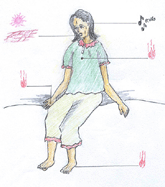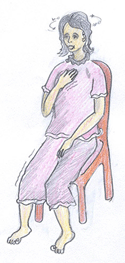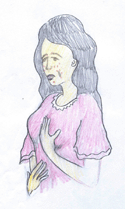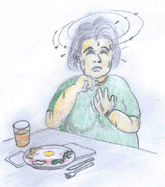How TCM Differentiates the Types of Infertility
- Location of disease between the exterior and interior body;
- Nature of disease between cold and heat;
- Individual constitutions that lean towards a deficiency or excess;
- Finally, generalizing the syndrome as yin or yang.
 The main manifestations are infrequent menstruation, delayed menstruation or menopause. Menses are generally light colored, thin and scanty. Individuals usually have watery or excessive white-turbid vaginal discharge. Other associated symptoms are soreness in the lumbar (lower back) and knee regions, fatigue, general weakness, puffiness, aversion to coldness, limb coldness, a cold feeling in the lower abdomen, low libido, profuse and clear urine, nocturnal urination, loose bowels, black eyes, a dull complexion and darkish spots on the face.
On examination, the tongue is pale and tender covered by a white and moist fur. The pulse is deep and slow or deep, thready and weak.
2. Kidney-yin deficiency
The main manifestations are infrequent menstruation, delayed menstruation or menopause. Menses are generally light colored, thin and scanty. Individuals usually have watery or excessive white-turbid vaginal discharge. Other associated symptoms are soreness in the lumbar (lower back) and knee regions, fatigue, general weakness, puffiness, aversion to coldness, limb coldness, a cold feeling in the lower abdomen, low libido, profuse and clear urine, nocturnal urination, loose bowels, black eyes, a dull complexion and darkish spots on the face.
On examination, the tongue is pale and tender covered by a white and moist fur. The pulse is deep and slow or deep, thready and weak.
2. Kidney-yin deficiency
 Individuals present with frequent or infrequent menstruation; the menses are bright red but scanty. Other associated symptoms are being thin in appearance, annoying hot sensations in the chest, palms and soles, soreness in the lumbar and knee regions, insomnia, night sweats, ear ringing and a dry mouth.
On examination, the tongue is red and tender with a little or no fur covering. The pulse is thready and weak or a little bit rapid.
3. Blood and Qi weakness
Individuals present with frequent or infrequent menstruation; the menses are bright red but scanty. Other associated symptoms are being thin in appearance, annoying hot sensations in the chest, palms and soles, soreness in the lumbar and knee regions, insomnia, night sweats, ear ringing and a dry mouth.
On examination, the tongue is red and tender with a little or no fur covering. The pulse is thready and weak or a little bit rapid.
3. Blood and Qi weakness
 The main manifestations are excessive or scanty menses, which are light-colored and thin. Individuals are usually delayed in menstruation and may have a dull pain in the lower abdomen after each cycle. Other associated symptoms are dizziness, palpitations, dull or sallow complexion, fatigue, limb numbness and insomnia.
On examination, the tongue is pale with thin and white fur; the pulse is thready and weak or deep and thready.
4. Qi and blood stagnation
The main manifestations are excessive or scanty menses, which are light-colored and thin. Individuals are usually delayed in menstruation and may have a dull pain in the lower abdomen after each cycle. Other associated symptoms are dizziness, palpitations, dull or sallow complexion, fatigue, limb numbness and insomnia.
On examination, the tongue is pale with thin and white fur; the pulse is thready and weak or deep and thready.
4. Qi and blood stagnation
 The main manifestations are irregular menstruation and dysmenorrhea (painful menses). The menses are purplish dark with plenty of blood clots. There may also be infrequent menstruation. Other associated symptoms are scaly skin, purplish lips, brownish spots or pigmentation on the face, distending pain in the breasts and lower abdomen. Individuals usually suffer from uterine myoma (muscular tumor), ovarian cysts or masses in the pelvic region.
On examination, the tongue is darkish red. Bleeding spots may be found in the margin. The pulse is deep and taut.
5. Liver-qi stagnation
The main manifestations are irregular menstruation and dysmenorrhea (painful menses). The menses are purplish dark with plenty of blood clots. There may also be infrequent menstruation. Other associated symptoms are scaly skin, purplish lips, brownish spots or pigmentation on the face, distending pain in the breasts and lower abdomen. Individuals usually suffer from uterine myoma (muscular tumor), ovarian cysts or masses in the pelvic region.
On examination, the tongue is darkish red. Bleeding spots may be found in the margin. The pulse is deep and taut.
5. Liver-qi stagnation
 The main manifestations are irregular cycles with impeded menstrual flow. The color is darkish red with small pieces of blood clots. There is distending pain in the breasts and abdomen before the menstruation cycle begins. Other associated symptoms are an uneasy mind, irritability, depression, sighing, or feeling sad without reason in severe cases.
On examination, the tongue is darkish red with a thin and white fur. The pulse is deep and thready.
6. Interior struck by phlegm and dampness
The main manifestations are irregular cycles with impeded menstrual flow. The color is darkish red with small pieces of blood clots. There is distending pain in the breasts and abdomen before the menstruation cycle begins. Other associated symptoms are an uneasy mind, irritability, depression, sighing, or feeling sad without reason in severe cases.
On examination, the tongue is darkish red with a thin and white fur. The pulse is deep and thready.
6. Interior struck by phlegm and dampness
 The main manifestations are menopause or a delay in cycles, impeded menstrual flow and scanty menses. Individuals usually have excessive thick vaginal discharge. Other associated symptoms are being overweight, chest oppression, retching, poor appetite, loose bowels, a bright pale complexion, fatigue, excessive sweating, dizziness and heart palpitations.
On examination, the tongue is pale, bulky and tender and may have indentation markings around the margin from the teeth. White and greasy fur may cover it. The pulse is deep, slow and rolling.
It should be emphasized that infertility usually results from multiple factors; thus, individuals may present a complex syndrome in reality. An experienced physician is necessary for an accurate diagnosis. The table below provides a general reference about the Western classifications of infertility and the possible dominant TCM syndrome patterns.
The main manifestations are menopause or a delay in cycles, impeded menstrual flow and scanty menses. Individuals usually have excessive thick vaginal discharge. Other associated symptoms are being overweight, chest oppression, retching, poor appetite, loose bowels, a bright pale complexion, fatigue, excessive sweating, dizziness and heart palpitations.
On examination, the tongue is pale, bulky and tender and may have indentation markings around the margin from the teeth. White and greasy fur may cover it. The pulse is deep, slow and rolling.
It should be emphasized that infertility usually results from multiple factors; thus, individuals may present a complex syndrome in reality. An experienced physician is necessary for an accurate diagnosis. The table below provides a general reference about the Western classifications of infertility and the possible dominant TCM syndrome patterns.
|
Western Diagnoses |
TCM Syndrome Patterns |
|
Ovulation problems |
Kidney deficiency & excessive phlegm
Deficiency in kidney yin and kidney yang
Deficiency in kidney yin and liver yin
Virtual Heat due to yin deficiency
Kidney deficiency and blood stasis
|
| Uterine problems | Blood stasis Blood stasis & qi stagnation Blood stasis & qi stagnation |
|
Tubal problems
|
Blood stasis & qi stagnation
Damp-heat in lower burner
|
|
Immune problems |
Not specified, may show virtual heat due to yin deficiency sometimes. |


